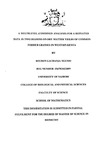| dc.description.abstract | Fodder grasses are the most common crops fed to dairy animals in Kenya. Although not directly used for human consumption, they are the source of protein and fat i.e. meat, milk and other dairy products that are available to human beings through intermediaries like cattle, sheep, goats, poultry etc. Performance of four grass fodder varieties on two different rainy seasons was evaluated to determine seasonal effects. The fodder grass varieties included in the study were; Bana grass, Cameroon grass, Bajra grass, and Giant Panicum (P. Maximum).
Two harvests (cuts) were made in each of the two seasons. The main objective of the study were to determine DM (dry matter) yield of the four varieties in the two different rainy seasons and to determine the effects of cutting times on fodder yields. Kenya has two very different rainy seasons; Long rain. season and short rain season. The total mean yield of the four fodder varieties was high in long rain season (7.14 tlha) compared to the total mean yield of the short season (2.63 t/ha) in the first cut.
The mean yield of second cut during short rain season is higher (7.33 t/ha) compared to the mean yield of Long rain (5.97 t/ha). Season had significant effect on the yield (p<O.OOOI for cut 1 and p=O.0067 for cut 2) of fodder grass varieties. The significant reduction in yield during the short rain season could be due to inadequate moisture causing reduction in vegetative growth.
Examining the effect of seasons and treatments interaction of the two harvests (cut 1 and cut 2), showed significance (p=O.0067 and p<O.OOI) respectively) meaning that a number of fodder grass varieties produced higher dry matter yield in one of the season than the other. The results of this study indicate that harvest management of fodder grass should vary according to season. There is need of farmers in Kenya to beef up moisture requirement during short rain season to have adequate surplus of fodder crop throughout the year. | en_US |

